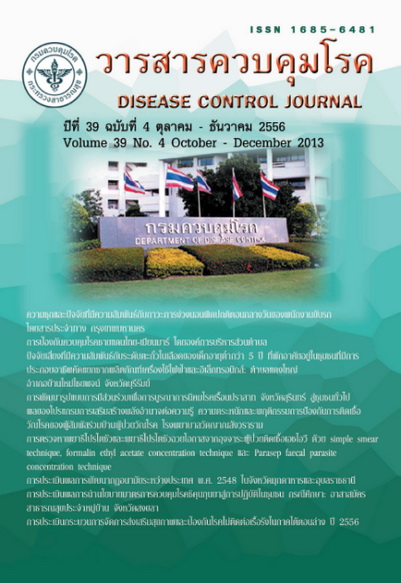Evaluation on the implementation of Chikungunya control measure at community level: a case study of the Village Health Volunteers Songkhla Province
DOI:
https://doi.org/10.14456/dcj.2013.8Keywords:
Chikungunya control measure, Village Health VolunteersAbstract
This study aimed to evaluate the implementation of Chigunkunya control measure from policy to practice in a community by the village health volunteers (VHV). The CIPP Model was applied to evaluate in 4 components: context, input, process, and product. The 4,570 VHVs in Thepa, Chana, Sabayoi, and Sadao District in Songkhla Province were stratified randomly sampled to be 368 samples. The questionnaire was pretested for reliability and used for data collection. The statistical analysis was performed and presented by using descriptive statistics. The results revealed that the samples were mostly female with age group of 40- 49 years and graduated primary school level. Their experience of working as VHV was less than 10 years. Each VHVs responded an average of 10-19 households. The context of control measure implementation was in good level. The control measure was relevant to the faced problems in the community. Input component was appropriate and adequate which its score was in fair level. The budgets, materials, equipments, preparedness of the community and knowledge of the community leaders including VHVs were fair. The process; the control measure practice in the villages where had no reported case, and ones with any cases had been reported, was good while the control measure practice in the village with a case occurring was fair. The products of control measure practice in community were an active cases finding activities in village (75.9%), less mosquito breeding sites (House index = 0.20 - 9.61) and no any reported cases in controlled villages (79.6%). This study could demonstrate the potential of the VHVs in active surveillance, early detection and disease control timely to prepare for epidemics of the emerging and re-emerging diseases in the near future.
Downloads
References
2. ชำนาญ ม่วงแดง. บทเรียนจากไข้ปวดข้อยุงลาย การเตินทางครั้งใหม่บนเสนทางสายเติม. กรุงเทพ- มหานคร: ชุมนุมสหกรณ์การเกษตรแห่งประเทศ- ไทย; 2553.
3. พีลิษฐํวุธ อยุทธ, ธงชัย เลิศวิไลรัตนพงศ์, สุวิช ธรรมปาโล, วิรัซ วงศ์หิรัญรัช และ สวรรยา จันทูตานนท์. การสำรวจโรคซิคนกุนยาและปัจจัยเสิยง ในหมู่บ้าน อำเภอยี่งอ จังหวัดนราธิวาส. รายงาน การเฝืาระวังทางระบาดวิทยาประจำสัปดาห์ เดือนตุลาคม 2551. นนทบุรี: สำนักระบาดวิทยา; 2551.
4. รจนา วัฒนรังสรรศ์, วรสิทธี้ ศรศรีวิชัย, สรรพงห์ ฤทธิรักษา, สุวัฒนั วิชัยพงห์สกุล. การดีกษาการ ระบาดของโรคซิคุนกุนยา อำเภอเทพา และอำเภอ จะนะ จังหวัดสงขลา. รายงานการเฝืาระวังทาง ระบาดวิทยาประจำสัปดาห์ เดือนมีนาคม-เมษายน 2551. นนทบุรี: สำนักระบาดวิทยา; 2552.
5. Thammapalo ร, Thaikruea L, Prickchoo p, et al. Factors contributing to rapid spreading of Chikungunya epidemimic in Thailand 2008- 2009. Technical Consultation on the Reemer¬gence of Chikungunya fever; 26-28 August 2009; Graceland Phuket Thailand.
6. สุวิซ ธรรมปาโล, ปฐมพร พริกชู และชูศักด โมลิโต. การรับรู้และพฤติกรรมการป้องกันตัวจากไท้ ชัคุนกุนยา เอกสารประกอบการประชุมประเมีน สถานการณ์โรคซิคุนกุนยาภาค'ใต้ 2552. (เอกสาร อัดสำเนา).
7. ศูนย์ปฏิบัติการควบคุมโรคไท้ปวดท้อยงลาย ภาคใต้. ศู่มือการดำเนินการศูนย์ปฏิบ้ตการควบคุมโรคไท้ปวดท้อ ยุงลายภาคใต้ ยุทธการ 90 วันใต้ร่วมใจต้านภัย ไท้ปวดท้อยุงลาย. นนทบุรี: กระทรวงสาธารณสุข; 2552.
8. นิศา ชูโต. การประเมินโครงการ. กรุงเทพมหานคร: พี.เอ็น. การพิมพ์; 2538.
9. สมหวัง พีธิยาบุวัฒนั. รวมบทความทางการประเมิน โครงการ. กรุงเทพมหานคร: จุฬาลงกรณ์ มหาวิทยาลัย; 2540.
10. Yamane T. Statistics, an introductory analysis, 2nd ed. New York: Harper and Row; 1967.
11. Wonghirunrat พ, Moonmek ร, Wasinee ร. The survey of Aedes albopictus breeding ource in the urban and rural areas. Technical Consultation on the Reemergence of Chikungunya fever; 2009 Aug 26-28; Phuket, Thailand.
12. วิรัช วงศ์หิรัญรัชศ์, ชูศักดี้โมลิโต, โสภาวดี มูลเมฆ. การดีกษาเปรียบเทียบประสิทธิภาพการ พ่นหมอกควันและพ่นฝอยละอองรถยนต้ไนการ ควบคุมยุงลายบ้านในเขตเทศบาลเมีองสงขลา. สงขลา: สำนักงานป้องกันควบคุมโรคที, 12; 2552.
Downloads
Published
How to Cite
Issue
Section
License
Articles published in the Disease Control Journal are considered as academic work, research or analysis of the personal opinion of the authors, not the opinion of the Thailand Department of Disease Control or editorial team. The authors must be responsible for their articles.






